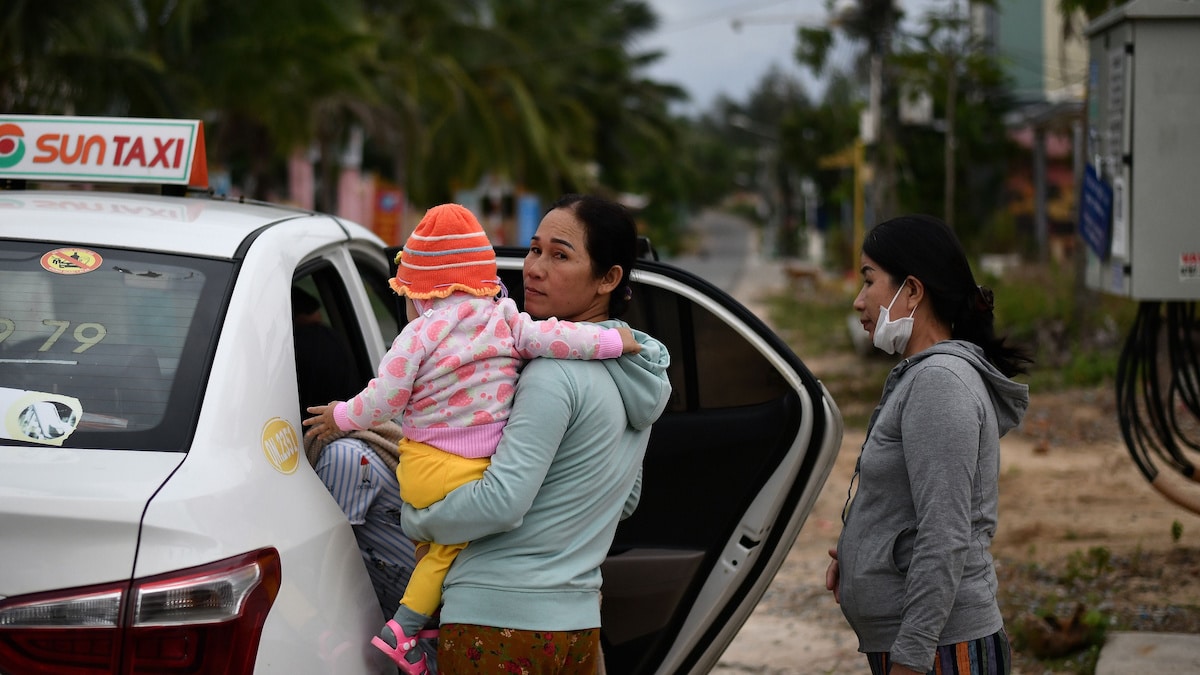
Vietnam Prepares to Evacuate 1.3 Million as Typhoon Molave Approaches

Residents get in a car after leaving their homes to move to evacuation centers in central Vietnam's Quang Nam province on Oct. 27, 2020, ahead of Typhoon Molave's expected landfall. MANAN VATSYAYANA / AFP via Getty Images
Typhoon Molave is expected to make landfall in Vietnam on Wednesday with 90 mph winds and heavy rainfall that could lead to flooding and landslides, according to the U.S. Embassy and U.S. Consulate in Ho Chi Minh City. To prepare for the powerful storm that already tore through the Philippines, Vietnam is making plans to evacuate nearly 1.3 million people along the central coast, as Reuters reported.
On Tuesday, hundreds of flights were grounded, and schools were closed as Molave churned over the South China Sea. When Molave hits Vietnam on Wednesday, it will be the fourth storm to strike the central region in October. Those successive storms have caused floods and landslides that killed 130 people. Many are still missing, according to the Sydney Morning Herald.
“This is a very strong typhoon that will impact a large area,” said Prime Minister Nguyen Xuan Phuc, as Reuters reported.
Molave is moving over a part of the South China Sea with warm waters, which creates favorable conditions for the storm to strengthen, according to AccuWeather.
Vietnam has a long coastline, which makes it particularly vulnerable to storms and coastal flooding. Phuc ordered boats to be brought ashore and for security forces to ready themselves for humanitarian efforts.
“Troops must deploy full force to support people, including mobilizing helicopters, tanks and other means of transportation if needed,” he said in a statement, according to Reuters.
The storm is expected to move over Vietnam quickly and weaken as it moves inland, but its heavy rainfall will likely trigger widespread flooding and weaken mountain slopes, which increases the risk for mudslides. AccuWeather predicts up to 16 inches of rain in areas of the country that have already experienced extreme rainfall and flooding since Oct. 11.
“We must keep our guard up to protect the lives of the people. That is the utmost important task to get people to safe places,” Phuc was quoted as saying in a meeting with disaster response officials, as the AP reported.
People in low-lying areas, who are vulnerable to the winds and coastal flooding, will head for shelter inland, according to the AP.
Typhoon Molave blew away from the Philippines on Monday, leaving flooding and a trail of destruction in its wake. There are 13 people missing in the Philippines, including a dozen fishermen who sailed out to sea over the weekend in violation of a no-sail order, according to the AP.
The storm, which traveled south of Manila, displaced at least 25,000 villagers. Its heavy rains swamped farming villages and the winds downed trees and power lines, according to Humerlito Dolor, governor of an affected province, as Deutsche Welle reported.
“Villagers are now asking to be rescued because of the sudden wind which blew away roofs,” he said, as Deutsche Welle reported.
- Protecting Mangroves Can Prevent Billions of Dollars in Global ...
- Typhoon Goni, One of the Strongest Storms on Record, Slams the Philippines - EcoWatch

 233k
233k  41k
41k  Subscribe
Subscribe 